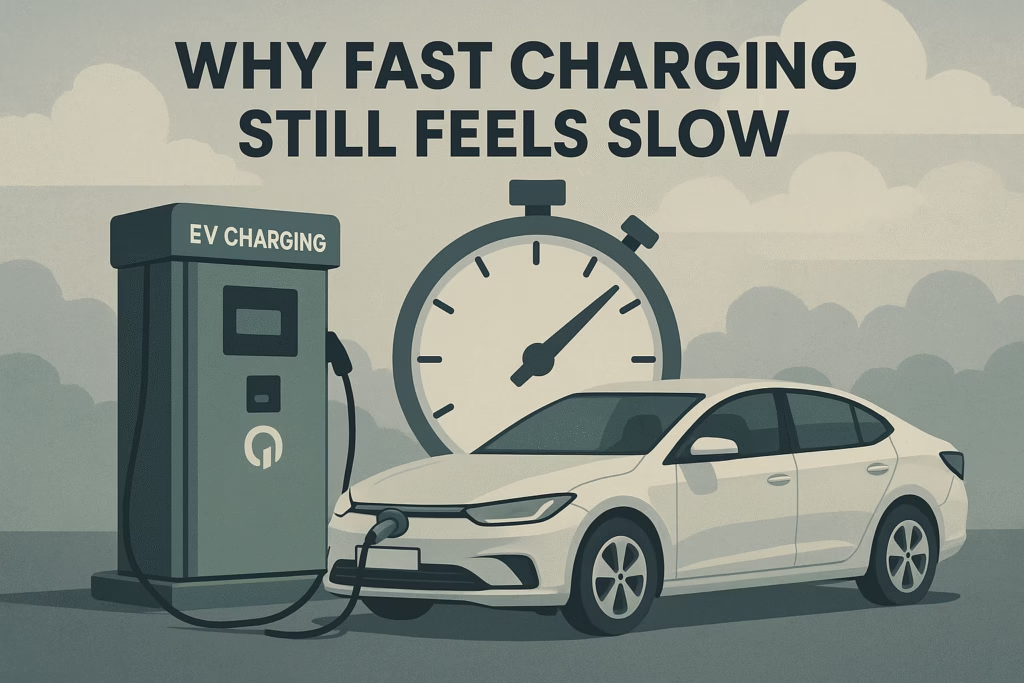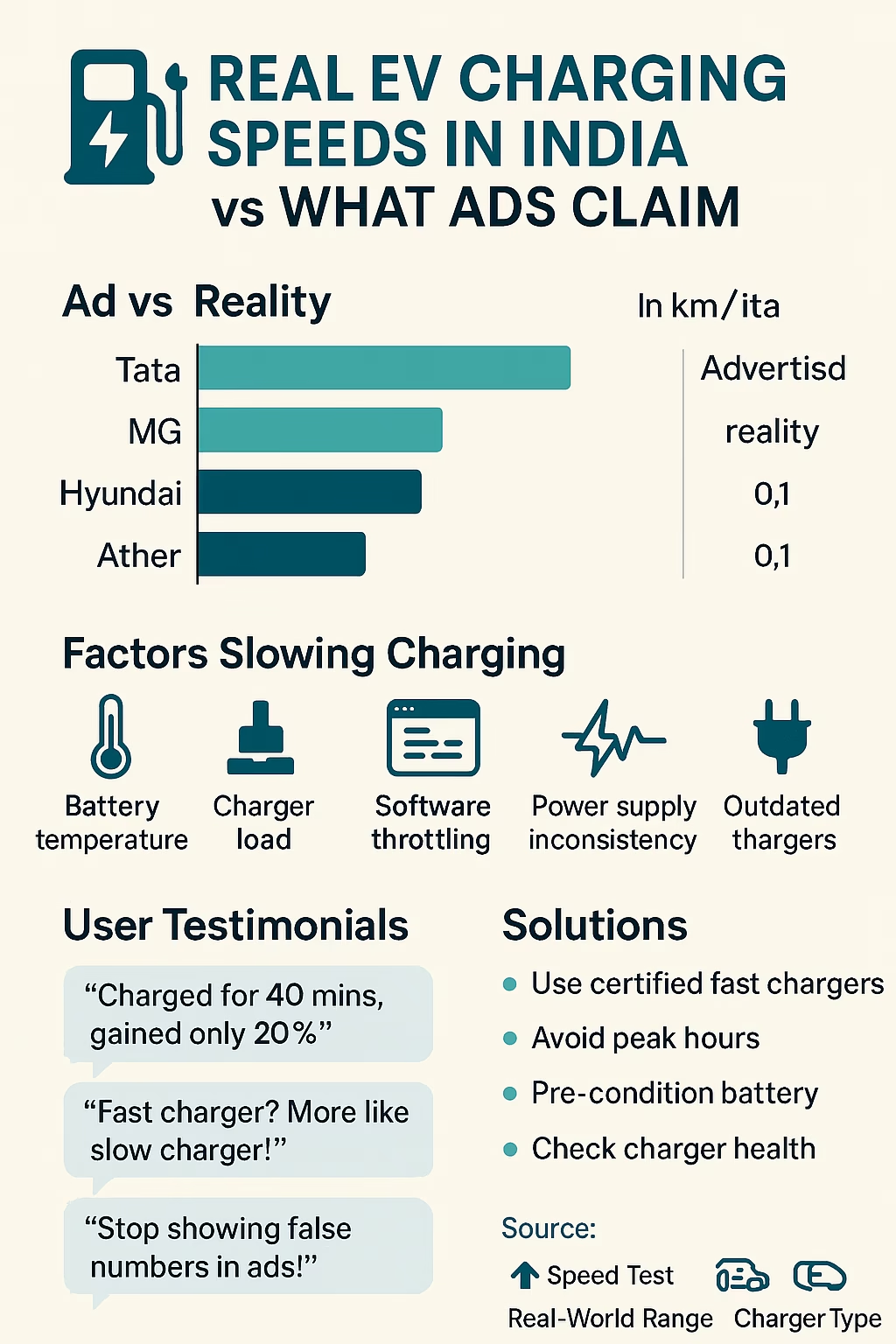Introduction: The Illusion of “Fast Charging” in India
When you buy an electric vehicle (EV), one of the first things you’re told is: “Don’t worry, it supports fast charging!” But months into owning your shiny new EV, reality hits — EV charging speed in India is often much slower than promised.

Whether you’re a city commuter or a highway cruiser, EV charging in India can be frustrating, inconsistent, and painfully time-consuming. So, why is this happening?
Let’s break it down.
Section 1: What Fast Charging Actually Means (and What It Doesn’t)
Manufacturers throw around terms like “DC fast charging” or “ultra-fast charging,” but they rarely explain the fine print. Here’s what you need to know:
- AC Charging (Slow Charging): Usually 3.3kW to 7.2kW. Takes 6–10 hours for a full charge.
- DC Fast Charging: Ranges from 15kW to 120kW. Can charge up to 80% in 40–60 minutes — on paper.
But here’s the catch: EV charging speed in India is rarely consistent with these numbers due to several ground-level realities.
Section 2: 7 Real Reasons Fast Charging Feels So Slow in India
1. Charger Output ≠ What You Get
A station may say “60kW,” but you only get 15–20kW due to:
- Power load restrictions
- Grid sharing with nearby businesses
- Battery state-of-charge (SOC) limitations
2. Battery Temperature Plays a Role
In Indian summers, your EV battery can overheat. If it’s too hot or too cold, the Battery Management System (BMS) slows the charge rate. So, even if you’re at a 60kW charger, you may only receive 8–12kW.
3. Low Infrastructure Density
The biggest problem with EV charging speed in India isn’t just speed—it’s availability.
- Long queues at limited stations
- No backup charger if one fails
- Often only 1–2 functional points per location
4. Poor Maintenance of Chargers
Many public charging stations in India suffer from:
- Software errors
- Broken connectors
- Non-responsive screens
Even if the charger is marked “Available” on apps like Statiq or ChargeZone, it may be out of service.
5. EV Model Compatibility
Not all EVs support high-speed DC charging. Budget models may max out at 30kW or less—even if you plug into a 60kW charger. Your car dictates your EV charging speed in India more than the charger itself.
6. Shared Charging Loads
Some stations connect multiple EVs to a single power supply. The more cars plugged in, the slower your charge becomes.
7. Faulty App Integrations
Some chargers require app-based authentication. If there’s poor connectivity or an app crash, your charging session can take 10–15 minutes just to start.

Section 3: EV Charging Speed in India – What the Data Says
According to a NITI Aayog study:
- 60% of India’s fast chargers deliver less than 50% of their rated speed.
- 1 in 4 stations has long wait times of 30+ minutes.
- Most users spend 45–90 minutes for what’s advertised as a “30-minute charge.”
This clearly shows a mismatch between advertisement and real-world EV charging speed in India.
Why EV Charging Stations in India Are Often Non‑Functional or Slow EV Charging at Public Stations?
Section 4: Real-Life User Stories
🔋 Rohit, Delhi:
“I went to a 60kW charger on the Delhi-Gurgaon highway. My Tata Nexon EV got 12kW at best. Took me over an hour.”
🔋 Maya, Pune:
“I planned a weekend trip to Lonavala. Had to stop 3 times due to either non-functional chargers or insanely slow speeds.”
Section 5: The Role of Government & Private Companies
The government is pushing the FAME II scheme and Battery Swapping Policy, but adoption is slow. Private players like:
- Tata Power
- Ather Grid
- Statiq
- ChargeZone
- Bolt.Earth
…are expanding fast-charging networks, but these are limited to metros or major highways.
The core issue? No unified standards or nationwide fast charging strategy.
Section 6: How You Can Maximize EV Charging Speed in India
✅ Choose Verified Locations
Always check apps like PlugShare or EV Plugs for live status and user reviews.
✅ Arrive With Lower SOC
Charging from 20% to 60% is much faster than from 60% to 100%.
✅ Avoid Peak Hours
Try early morning or late-night sessions to avoid queues and get full charger power.
✅ Use Compatible Chargers
Make sure the station supports your vehicle’s max charge rate (CCS2, CHAdeMO, Type 2 AC, etc.)
✅ Monitor Battery Health
Regular servicing ensures BMS works well and your battery doesn’t throttle charging.
Section 7: The Future of EV Charging Speed in India
🚗 By 2030, India plans to install over 1 million public EV chargers.
But challenges remain:
- Grid upgrades needed
- Battery cooling tech must improve
- More charger density in tier-2/3 cities
Faster chargers are coming, but so are more EVs. This means more users, longer queues — and the EV charging speed in India will stay a bottleneck unless we fix infrastructure and expectations.
Conclusion: It’s Time for Honest Communication
Yes, EVs are the future. But until we fix real-world problems around EV charging speed in India, fast charging will remain more “promise” than “practice.”
If you’re buying or already own an EV, know the facts, manage your expectations, and plan smarter.
Because in India today, fast charging doesn’t always mean fast.

